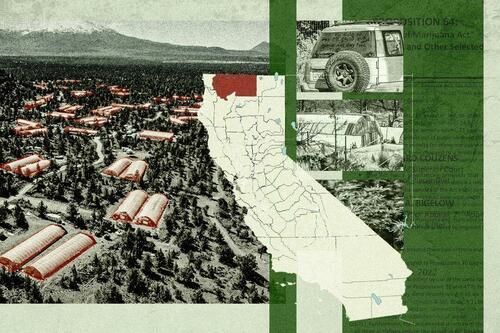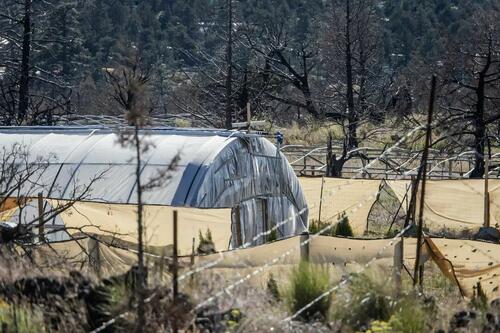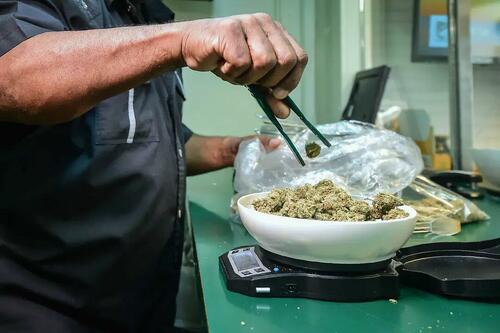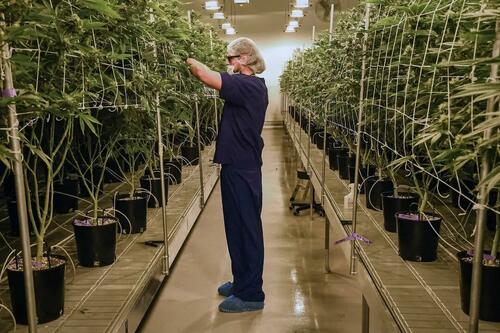How Uninhabited Terrain Became A Hotbed For Black Market Marijuana
Authored by Brad Jones via The Epoch Times (emphasis ours),
The air is thick with the unmistakable pungent stench of cannabis plants in a massive network of illegal grow operations in a rural part of northern California, as Mount Shasta looms on the horizon.

Gated-off with chain link and wire fences—some with tattered shreds of privacy screening—the properties northeast of Weed, Calif., near Montague, are a compound of ramshackle huts, old RVs, and cheaply-made greenhouses of hoops and plastic.
Several spotters in vehicles patrol the dusty roads, watching for police and intruders near the site off Shasta Vista Drive.
These “guards” are often armed with automatic rifles, according to Siskiyou County Sheriff Jeremiah LaRue.
The sheriff estimates about 90 percent of the nearly 2,000 properties in the Mount Shasta Vista subdivision are involved in illegal grow operations.
Miles from Interstate 5, the illegal grow operations are out-of-sight and out-of-mind for most people, but even a glance at a satellite map reveals the vast network.
“If you zoom out, that subdivision is pretty large—nine square miles,” Mr. LaRue said.
The lots are on volcanic soil. Unsuitable for water wells and septic systems, the land is far from an ideal spot to build a “dream home,” he said.
The once essentially uninhabited terrain is now scattered with makeshift shelters and other structures built without permits in camps that look like they belong “in a third-world country,” he said.
The illegal cannabis operations have brought serious crime, including robberies, theft, and five unsolved homicides, he said.
A recent armed robbery allegedly involved outsiders robbing people who were selling marijuana, Mr. LaRue said.
“That doesn’t happen, generally speaking, to people that are growing alfalfa or cherries, or strawberries or corn. So, it’s a crop that really brings just a massive amount of violent crime with it,” he said. “People are willing to die for marijuana for some reason.”
Legalizing Marijuana
More than 57 percent of California voters approved Proposition 64, the Adult Use of Marijuana Act, in 2016, which legalized the recreational use of marijuana.
Californians have led the push to soften cannabis laws in the United States since 1972 with Proposition 9, a failed ballot initiative that attempted to legalize marijuana. Eventually, in 1996, more than 55 percent of state voters supported Proposition 215 allowing the medical use of cannabis.
But unlicensed cannabis cultivation and sales are prohibited, and cultivation is still illegal under federal law.
Around 2015, a group of about 100 people moved from the Midwest and bought private property in Siskiyou County, where they started cultivating outdoor marijuana grows, Mr. LaRue said.
The land was cheap then; 2.5-acre parcels sold for about $500, but today the same land is worth between $30,000 to $40,000 because illegal grow operations are lucrative and the sites are in high demand, he said.
He estimates there are currently about 10,000 people involved in illegal cannabis cultivation.
Nearly 5,000 “hoop houses,” a term the sheriff prefers to describe the makeshift greenhouses, cultivating three crops a year means the black market sites generate billions of dollars in profits, he said.
Property owners have brought in illegal pesticides and other toxic chemicals, many from China, that are “destroying the environment,” he said.
His deputies do the best they can to avoid contamination from unregulated and illegal pesticides found during routine raids, but Mr. LaRue said he worries about the risks they could face from long-term exposure to such toxins.
Recent traffic stops show that illegal cannabis is going to licensed locations and that the legal market is also being supplied by the black market, he said.
“Everything has kind of turned into what I call the gray market because everything is just dirty,” he said. “You really don’t know what’s legit and what isn’t … and the average user has no clue.”
This makes the illegal pesticide issue even more alarming because “those chemicals are now on the product that’s going into legal dispensaries,” he said.
“People are buying it as medicine for cancer patients and actually just smoking and consuming carcinogens. That should be troubling for the state. That’s a public health issue.”
Penalties for Illegal Cultivation
Proposition 64, or the Adult Use Marijuana Act, which took effect in November 2016, allowed adults over age 21 to legally grow and harvest up to six plants.
Under California law, it is a felony to plant, cultivate, harvest, dry, or process more than six cannabis plants “to intentionally or with gross negligence cause substantial environmental harm to surface or groundwater,” the California Department of Cannabis Control (DCC) said in a statement emailed to The Epoch Times.
Anyone 18 years or older convicted of planting, cultivating, harvesting, drying, or processing more than six living cannabis plants can face misdemeanor charges and up to six months in a county jail or a fine of up to $500, or both, under Article 11358 of the California Health and Safety Code.
Penalties for anyone under age 18 include up to eight hours of drug counseling or up to 40 hours of community service, or both, according to the National Organization for the Reform of Marijuana Laws.
The DCC did not provide any statistics indicating how many people, if any, have been convicted and sentenced to jail time and stipulated that the prosecution of such crimes “is dependent on the jurisdiction where they occurred.”
In practice, for illegal cultivation to be prosecuted as a felony, the crime is usually tied to an environmental infraction, Siskiyou County District Attorney Kirk Andrus told The Epoch Times.
“It’s a misdemeanor all day long no matter how much you grow unless you have an environmental violation, and so that takes us some work to prove,” Mr. Andrus said.
Meanwhile, the state is losing tax revenue, and some people who entered the legal cannabis market thinking they can make a profit are going out of business, he said.
“If they want to make marijuana legal for recreational use, then defend the white market. The black market is killing the white market,” he said.
“We have a black market in this county that’s the size of a small nation. I’m not a marijuana proponent but if it’s going to be legal, defend your market by letting us eradicate the black market.”
Potential Remedies and Solutions
While Mr. LaRue admits there’s no quick fix for the crisis, he has urged the governor to take executive action to “free up money” for rural communities where police funding often falls short and implement more “aggressive” enforcement policies.
“Not just in words but in action,” he said.
Funding for six deputies to cover nearly 6,300 square miles and only two to deal with illegal grow operations just isn’t enough, Mr. LaRue said.
He urged state lawmakers to take a closer look at what’s happening in Siskiyou County.
“They need to look at it as an actual problem and get some laws on the books that would actually deter people from continuing this,” he said, stressing that his intent—and the purpose of tougher laws—is “not to lock everyone up in prison.”
Read more here…
Tyler Durden
Sat, 06/29/2024 – 17:30
via ZeroHedge News https://ift.tt/Y8RH34t Tyler Durden


